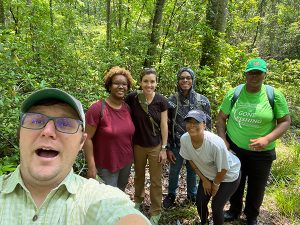
TUSCALOOSA, Ala. – A student-led team from The University of Alabama has received a federal award for its research into helping private well owners in Alabama predict and identify the risk of water contamination after flooding.
The team received $24,899 from the United States Environmental Protection Agency’s People, Prosperity and the Planet, or P3, student design competition.
The team of one graduate student, Jourdan Kiaupa, and three undergraduate students, Jaylin Jones, Justus King and Justice Osuala, is being advised by Dr. Leigh Terry, UA assistant professor of civil, construction and environmental engineering, and Dr. Nate Jones, UA assistant professor of biological sciences. Dr. Nikaela Flournoy, an assistant professor of biology at Miles College, is also assisting on the project.
The project will develop a flood-induced contamination risk assessment model for Alabama’s underserved Black Belt region using spatial analysis and known private well locations. It will also develop user-friendly water quality testing packets that include educational materials to bring awareness to the threats of well water contamination. The materials will detail flood recovery protocol, risks of microbial contamination and emergency contact information.
“Private well owners are responsible for ensuring the safety of their well water,” said Terry. “Our goal is to empower the larger well water user community to both better understand their drinking water quality and take action after that quality has been degraded.”
Direct beneficiaries of the project include state and local water quality regulators, governments and the general public in addition to private well owners.
Terry’s students wrote the proposal as part of her environmental engineering microbiology graduate course. The proposal helped them learn how to write grants and train them in issues that face private well owners in the Gulf Coast region.
“Writing a proposal is hard work, so the students were encouraged to have their ideas selected by the EPA,” she said. “It is exciting the agency is funding projects to ensure safe water for all communities.”
The students will perform the well water sampling, analysis and kit testing under Jones and Terry’s mentorship and supervision.
In addition to developing a spatial analysis model and providing educational materials, the team will also determine the efficacy of pre-manufactured water quality testing strips by collecting samples from UA’s monitoring wells. The project will include a final report and model that will identify areas in the state that are at risk of well contamination.
Although the team currently has four students, more will be added as they return for the fall semester and get closer to the project’s launch. Both graduate and undergraduate students will lead the multidisciplinary effort that will benefit many citizens.
“The project brings engineers and scientists together to improve public health, empower individual well owners and improve the lives of rural residents across the Gulf Coast,” said Terry.
Brock Parker, Multimedia Specialist and Writer, Alabama Water Institute